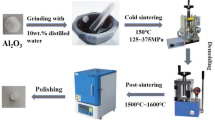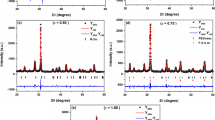Abstract
Lead-free 0.98(K0.5Na0.5)NbO3–0.02(Ba0.6Sr0.4)0.7Bi0.2TiO3 (abbreviated as 0.98KNN–0.02BSBT) ceramics were prepared by the conventional solid-state sintering method. Effect of sintering temperature on 0.98KNN–0.02BSBT ceramics was systematically investigated. The frequency dependent dielectric permittivities show that the ceramics sintered at different temperatures are indeed “relaxor-like” ferroelectric ceramics, which possess a diffuse phase transition without a strong frequency dispersion of dielectric permittivity. The diffuseness parameter γ, the comparison of the relaxor behavior based on empirical parameters (ΔT diffuse) and the slimmer P–E hysteresis loops confirm that the “relaxor-like” characteristics of the ceramics are strengthened with increasing sintering temperature. At the optimum sintering temperature, the dielectric permittivity maximum (ɛ max) has a value of approximately 2795 (at 1 KHz), \( \tan \delta \) is lower than 2.5 % and the diffuseness parameter γ = 1.68 at a broad usage temperature range (150–350 °C), which indicate its potential application in high temperature multilayer ceramics capacitor field.







Similar content being viewed by others
References
Eitel RE, Randall CA, Shrout TR, Park SE (2002) Preparation and characterization of high temperature perovskite ferroelectrics in the solid solution (1−x)BiScO3–(x)PbTiO3. Jpn J Appl Phys 41(4a):2099
Ryu J, Priya S, Uchino K (2003) High-Tm relaxor ferroelectrics: 0.3BiScO3–0.6PbTiO3–0.1Pb(Mn1/3Nb2/3)O3. Appl Phys Lett 82:251
Zhang SJ, Stringer CJ, Xia R, Choi SM, Randall CA, Shrout TR (2005) Investigation of bismuth-based perovskite system: (1−x)Bi(Ni2/3Nb1/3)O3–xPbTiO3. J Appl Phys 98(3):034103
Stringer CJ, Randall CA (2007) In situ TEM investigations of the high-temperature relaxor ferroelectric BiScO3–Pb(Mg1/3Nb2/3)O3–PbTiO3 ternary solid solution. J Am Ceram Soc 90(6):1802–1807
Stringer CJ, Donnelly NJ, Shrout TR et al (2008) Dielectric characteristics of perovskite-structured high-temperature relaxor ferroelectrics: the BiScO3–Pb(Mg1/3Nb2/3)O3–PbTiO3 ternary system. J Am Ceram Soc 91(6):1781–1787
Jiang YH, Zhao Y, Qin BQ, Jiang YZ (2008) Dielectric and piezoelectric properties of (1−x)(Bi(1−y)Li y ) × (Sc1−y Sb y )O3–xPbTiO3 high-temperature relaxor ferroelectric ceramics. Appl Phys Lett 93:022904
Yuan Y, Zhao CJ, Zhou XH (2010) High-temperature stable dielectrics in Mn-modified (1−x)Bi0.5Na0.5TiO3–xCaTiO3 ceramics. J Electroceram 25:212–217
Dittmer R, Jo W, Damjanovic D, Rodel J (2011) Lead-free high-temperature dielectrics with wide operational range. J Appl Phys 109:034107
Dittmer R, Anton EM, Jo W (2012) A high-temperature-capacitor dielectric based on K0.5Na0.5NbO3-modified Bi1/2Na1/2TiO3–Bi1/2K1/2TiO3. J Am Ceram Soc 95:3519–3524
Ogihara H, Randall CA, McKinstry ST (2009) Weakly coupled relaxor behavior of BaTiO3–BiScO3 ceramics. J Am Ceram Soc 92:110–118
Ogihara H, Randall CA, Trolier-McKinstry S (2009) High temperature and high energy density dielectric materials’. J Am Ceram Soc 92:106–113
Lim JB, Zhang SJ, Kim N (2009) High-temperature dielectrics in the BiScO3–BaTiO3–(K1/2Bi1/2)TiO3 ternary system. J Am Ceram Soc 92:679–682
Lim JB, Zhang S, Shrout TR (2011) High temperature capacitors using a BiScO3–BaTiO3–(K1/2Bi1/2)TiO3 ternary system. Electron Mater Lett 7:71–75
Raengthon N, Sebastian T, Cumming D (2012) BaTiO3–Bi(Zn1/2Ti1/2)O3–BiScO3 ceramics for high-temperature capacitor applications. J Am Ceram Soc 95:3554–3561
Raengthon N, Cann DP (2012) High temperature electronic properties of BaTiO3–Bi(Zn1/2Ti1/2)O3–BiInO3 for capacitor applications. J Electroceram 28:167–171
Yang ZP, Chao XL, Li Z (2012) Phase structures, electrical properties and temperature stability of (1−x)[(K0.458Na0.542)0.96Li0.04](Nb0.85Ta0.15)O3–xBiFeO3 ceramics. J Alloy Compd 518:1–5
Du HL, Zhou WC, Luo F (2008) High Tm lead-free relaxor ferroelectrics with broad temperature usage range: 0.04BiScO3–0.96(K0.5Na0.5) NbO3. J Appl Phys 104:044104
Wu JG, Xiao DQ, Wang YY (2008) Improved temperature stability of CaTiO3-modified [(K0.5Na0.5)0.96Li0.04](Nb0.91Sb0.05 Ta0.04)O3 lead-free piezoelectric ceramics. J Appl Phys 104:024102
Du HL, Zhou WC, Luo F (2009) Phase structure, dielectric properties, and relaxor behavior of (K0.5Na0.5) NbO3–(Ba0.5Sr0.5)TiO3 lead-free solid solution for high temperature applications. J Appl Phys 105:124104
Du HL, Zhou WC, Luo F (2010) New lead-free relaxor ferroelectrics derived from (K0.5Na0.5)NbO3 for high temperature applications. Ferroelectrics 401:141–147
Zhao JB, Du HL, Qu SB (2011) The effects of Bi(Mg2/3Nb1/3)O3 on piezoelectric and ferroelectric properties of K0.5Na0.5NbO3 lead-free piezoelectric ceramics. J Alloys Compd 509:3537–3540
Cheng HL, Du HL, Zhou WC (2013) Bi(Zn2/3Nb1/3)O3–(K0.5Na0.5)NbO3 high-temperature lead-free ferroelectric ceramics with low capacitance variation in a broad temperature usage range. J Am Ceram Soc 96:833–837
Cheng HL, Zhou WC, Du HL (2013) Enhanced dielectric relaxor properties in (1−x)(K0.5Na0.5)NbO3–x(Ba0.6Sr0.4)0.7Bi0.2TiO3 lead-free ceramic. J Alloy Compd. doi:10.1016/j.jallcom.2013.06.077
Zhao P, Zhang BP, Li JF (2007) High piezoelectric d33 coefficient in Li-modified lead-free (Na, K)NbO3 ceramics sintered at optimal temperature. Appl Phys Lett 90:242909
Li JF, Zhen Y, Zhang BP, Zhang LM, Wang K (2008) Normal sintering of (K, Na)NbO3-based lead-free piezoelectric ceramics. Ceram Int 34:783–786
Wang K, Li JF (2010) Low-temperature sintering of Li-modified (K, Na)NbO3 lead-free ceramics: sintering behavior, microstructure, and electrical properties. J Am Ceram Soc 93:1101–1107
Fang J, Wang XH, Zuo RZ (2011) Narrow sintering temperature window for (K, Na)NbO3-based lead-free piezoceramics caused by compositional segregation. Phys Status Solidi A 208:791–794
Du H, Tang F, Luo F, Zhu D, Qu S, Pei Z, Zhou W (2007) Influence of sintering temperature on piezoelectric properties of (K0.5Na0.5)NbO3–LiNbO3 lead-free piezoelectric ceramics. Mater Res Bull 42:1594–1601
Fisher JG, Kang SL (2009) Microstructural changes in (K0.5Na0.5)NbO3 ceramics sintered in various atmospheres. J Eur Ceram Soc 29:2581–2588
Zhao YJ, Zhao YZ, Huang RX (2011) Effect of sintering temperature on microstructure and electric properties of 0.95(K0.5Na0.5)NbO3–0.05Li(Nb0.5Sb0.5)O3 with copper oxide sintering aid. J Am Ceram Soc 94:656–659
Liang WF, Xiao DQ, Wu WJ (2011) Effect of sintering temperature on phase transitions, properties and temperature stability of (K0.465Na0.465Li0.07)(Nb0.95Sb0.05)O3 lead-free piezoelectric ceramics. Curr Appl Phys 11:S138–S142
Shao B, Qiu JH, Zhu KJ (2012) Influence of sintering temperature on microstructure and electric properties of CuO doped alkaline niobate-based lead-free ceramics. J Mater Sci 23:1455–1461. doi:10.1007/s10854-011-0611-7
Birol H, Damjanovic D, Setter N (2006) Preparation and characterization of (K0.5Na0.5)NbO3 ceramics. J Eur Ceram Soc 26:861–866
Uchino K, Nomura S (1982) Critical exponents of the dielectric constants in diffused-phase-transition crystals. Ferroelectr Lett Sect 44:55–61
Chen W, Yao X, Wei XY (2007) Tunability and ferroelectric relaxor properties of bismuth strontium titanate ceramics. Appl Phys Lett 90:182902
Shvartsman VV, Lupascu DC (2012) Lead-free relaxor ferroelectrics. J Am Ceram Soc 95:1–26
Du HL, Zhou WC, Luo F et al (2008) Sintering characteristic, microstructure, and dielectric relaxor behavior of (K0.5Na0.5)NbO3-(Bi0.5Na0.5)TiO3 lead-free ceramics. J Am Ceram Soc 91:2903–2909
Acknowledgements
This work was supported by the Doctorate Foundation of Northwestern Polytechnical University (No. CX201108), the National Natural Science Foundation of China (Grant No. 51072165), and the fund of State Key Laboratory of Solidification Processing in NWPU (No. KP200901).
Author information
Authors and Affiliations
Corresponding author
Rights and permissions
About this article
Cite this article
Cheng, H., Zhou, W., Du, H. et al. Effect of sintering temperature on phase structure, microstructure, and electrical properties of (K0.5Na0.5)NbO3–(Ba0.6Sr0.4)0.7Bi0.2TiO3 lead-free ceramics. J Mater Sci 49, 1824–1831 (2014). https://doi.org/10.1007/s10853-013-7870-z
Received:
Accepted:
Published:
Issue Date:
DOI: https://doi.org/10.1007/s10853-013-7870-z




